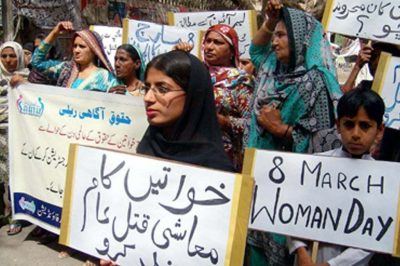Women are commemorating the Aurat March’s seventh year. A few women organized demonstrations in 2018 to demand legal protection and economic and political visibility, which sparked the phenomenon known as the Aurat march. Nevertheless, women have already taken to the highways to advocate for their rights.
The history of the Aurat March traces back to initiatives like the Women Action Forum, formed in 1981, challenging Zia’s Hudood decree. Further momentum was gained with the formation of “Girls at Dhaba” in 2010, aiming to reclaim public spaces. These early movements laid the foundation for ongoing protests advocating for women’s rights in Pakistan. The Aurat March, now in its seventh year, continues this legacy of defiance and advocacy.
Let us discuss the necessity for feminism in Pakistan and the reasons behind women’s roadside demonstrations. Women in Pakistan face many challenges. The country has a high rate of child and forced marriages, rape and sexual assault cases, and honor killings. Women face interrelated roots in existing gender disparities and insufficient investment in education.
According to a report by UNICEF Pakistan, Pakistan currently has the world’s second-largest number of out-of-school children (OOSC), with an estimated 22.8 million children aged 5 to 16 not attending school, accounting for 44% of the total population in this age range. Geographical, gender and socioeconomic disparities are severe; only in Sindh do 52% of the poorest children (girls) not attend school, and in Balochistan, 78% of girls do not attend school.
At the basic level, around 10.7 million boys and 8.6 million girls are enrolled; at the lower secondary level, there are 3.6 million boys and 2.8 million girls. Pakistan currently ranks among the world’s worst countries in terms of gender equality, only better than Iraq, Yemen, and Afghanistan. In the World Economic Forum’s (WEF) “Global Gender Gap Report 2021,” Pakistan indexed 153 out of 156 nations on the gender parity index.
Similarly, Pakistan was listed as the second-worst country after Afghanistan in the Global Gender Gap Report 2022. Moreover, according to the Human Rights Commission of Pakistan, 90% of women have experienced some violence, and 47% of married women have experienced sexual abuse. So, these are the appalling features and the grave indicator that there is a need for feminist movements in Pakistan.
The concept behind the feminist movement came from the West. During the first wave of feminism, women in the West battled for the right to vote; for this reason, the movement was originally called the Suffragette movement. The second struggle wave in the West was focused on equal participation in politics and the economy, whereas the third wave was characterized by radicalism.
Also Read: Understanding Depression -A Mental Health Perspective
Similarly, Pakistan is experiencing an intense feminist movement that is challenging the patriarchal culture of the nation. They are seeking their rights to property, education, and open spaces in addition to the cessation of salary discrimination. They aim to undermine patriarchal conventions and bring an end to the patriarchal system.
The seven-year Aurat March narrated the story of Pakistani women who are denied official recognition because of the country’s traditional social systems. In response to this march, opposition was encountered.
The clerics began criticizing and characterizing these women as “Shameless”, claiming that they were the source of social turmoil. The traditional social classes of Pakistan labeled them as a danger to the country’s moral principles and family unit. In addition to the clerics, members of society’s educated strata expressed criticism.
For example, the previous Prime Minister of Pakistan, Imran Khan, claimed that Pakistan does not require feminism because it is a Western concept. Even the Prime Minister has made reservations about how women should dress.
However, a countermarching in Lahore was also organized by religious organizations, and when these preachers claimed that the Aurat march was receiving support from the West, the protest turned violent. Specifically, Jamat Islami arranged a Haya march. However, the state’s acts are identical to those of the religious institution. Reasonably, the state seeks to reduce women’s voices by limiting them every year under the excuse of security concerns.
Integration and upholding women’s rights are imperative in confronting the undeniable reality of women’s rights violations in Pakistan. Societal inclusion benefits women and enhances economic stability, elevating Pakistan’s global standing. The nation needs to prioritize gender equality, fostering a society where women are empowered and respected. By championing women’s rights, Pakistan can pave the way for a brighter and more equitable future for all its citizens.
The writer, Sanan Hassan, is enrolled at Punjab University Pakistan to pursue an MPhil in International Relations.
** The opinions expressed in this article are solely those of the author and do not reflect the views or position of World Affairs Insider. The organization neither endorses nor takes responsibility for the content of this article and its accuracy.








